The First Pull Tabs: 1962-1964
The flat top can had been born in 1933 and first sold in 1935. It had outlasted its competition cans--cone tops and crowntainers--as the last cone top was filed in 1960, by Rice Lake Brewing in Wisconsin. Moreover, the flat top can was almost caught up with bottles in popularity with beer drinkers. Just two years after the last cone top was filled, however, a new competitor to the flat top can was being sold, the pull tab, or, as the early ones are known, the ZIP TOP.The zip top can was born in Dayton, Ohio in about 1959 out of necessity (Dayton also gave the world the airplane and the automobile self-starter which eliminated cranking a car to start it.) A tool and die maker named Ermal Fraze, according to legend, found himself at a picnic with beer, but no church key to open the cans! After an afternoon spent opening cans on a car bumper, Fraze decided that there had to be a better way. 1 Fraze was the right man to tackle the job. In 1949, he had founded Dayton Reliable Tool & Mfg. Co. (DRT) as "an independent designer and manufacturer of tool and die components and other manufactured products." 2 He was therefore familiar with working with metal, including aluminum. Still, the problem required some clever engineering. Fraze had to figure out how to notch an opening into a can top so that it will be easy to remove but still strong enough to hold against the can's internal pressure. If the scoring around the opening were too strong the customer wouldn't be able to open the can, but if it were too weak, the pull tab might be blown off prematurely by the high pressure of the carbonation rushing out of the hole made by a initial cracking of the tab. After some designing and testing the solution came to Fraze after a sleepless night working on the problem. He used the material in the lid itself to form a rivet holding the tab in place. 3
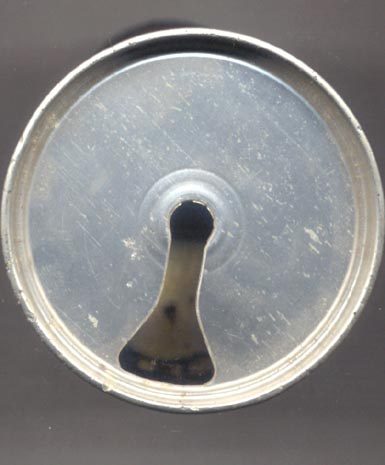 1. Top of the first pull tab can. No instructions, no smile beads. |
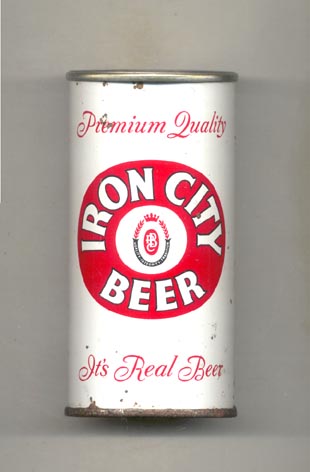 2. This is the first pull tab beer can ever made. |
Fraze sold the rights to the invention to Alcoa and they convinced Iron City Brewing in Pittsburgh to give these new tops a try. Iron City tested the first of the zip tops in March 1962 in Virginia, coincidentally where the first beer can had been tested in 1935. The test was a success and within a year Schlitz had followed Iron City's lead, with both beers advertising their new convenient tops. The zip top was not without problems, however. The first design had lots of sharp edges on both the tab and the opening, and there were complaints from customers about cut fingers, lips and even noses! 4 Some people also needed some instruction on how to use the new-fangled contraption. The words "Lift Tab, Pull Open" were added to the tops as were rounded edges on the tab, and "smile beads" on either side of the opening. The "beads" kept the beer from flowing out the sides of your mouth! Some beer drinkers kept their old habits refusing to use the new lids as they were designed: it's common when dumping to find zip tops which have holes from churchkeys in their lids or bottom. Sometimes the tab itself failed, leaving a small opening, the tab still in the lid of the can, and a frustrated thirsty drinker. (see can #2 in photo 5, below)
Even though Iron City's sale had increased 233% in a year, and national giant Schlitz had adopted the new tops, some brewers were reluctant to use the new device, in part because they added 1-5 cents in cost to the brewer for each six pack. One brewer noted "These tops cost more, and when the fad (emphasis added) wears off they won't sell that much more beer." The companies who made churchkeys, some 200 million year, also did not initially seem worried; "Sure they're a threat to us...but they'll have to be perfected a lot more to make a dent in our sales." 5
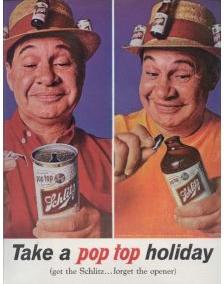 |
3. 1963 Schlitz Ad promoting the new pop top. |
 |
4. Iron City Can Bragging About Its New Top. |
Such views, however, were wildly off the mark. Schlitz promoted the new cans with a nationwide advertising campaign and the "fad" cans quickly found an audience. At the same time, Iron City began bragging in big bold letters on their cans that they were using the new top. By June 1963, 40 brands were using pull tabs. By 1965 three quarters of the breweries in the U.S. were using them. 6 The designs kept changing, however, in response to customer complaints and comments. The photo below shows the progression of opening styles from 1962 through 1964. The pull tab would continue to evolve with the ring pull in 1965, and with the StaTab can in 1975, but with the zip top can's introduction in 1962, the flat top can's days were numbered.
5. Seven different zip tops from 1962-64.
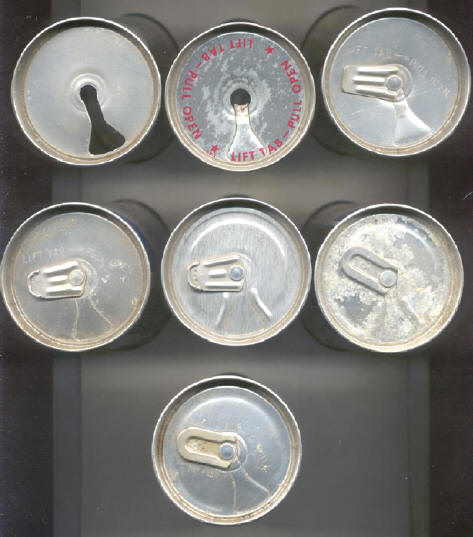 |
Top Row: Left to Right: Second Row: Left to Right: Bottom Can Dates are estimates. |
"Dogbone" Zips:
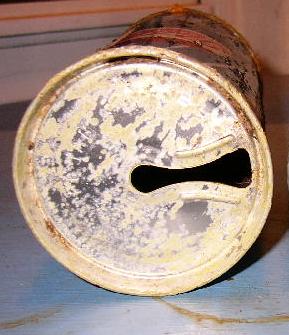 At some point in about 1964 the American Can Company marketed a zip top can with a very narrow opening. They apparently were not a success because only a few brewers tried them, and most didn't use this opening for very long. This type of opening is called a "dogbone" and a handful of collectors (myself included) collect them as a unique subgroup. Below is a list of all the known brands that used the "dogbone." (Mat need updating)
At some point in about 1964 the American Can Company marketed a zip top can with a very narrow opening. They apparently were not a success because only a few brewers tried them, and most didn't use this opening for very long. This type of opening is called a "dogbone" and a handful of collectors (myself included) collect them as a unique subgroup. Below is a list of all the known brands that used the "dogbone." (Mat need updating)
Brand |
Brewer |
American |
American, Baltimore |
American Dry |
Eastern, Hammonton |
Arrow 77 |
Globe |
Banner Beer |
Century, Norfolk |
Blanchards |
? |
Falls City |
Falls City, Louisville |
Garden State |
Eastern, Hammonton |
Kappy’s |
Eastern, Hammonton |
| Milwaukee Premium | Eastern, Hammonton |
Monticello |
Century, Norfolk |
Monticello Ale |
Century, Norfolk |
Old Bohemian |
Eastern, Hammonton |
Old Bohemian Draft |
Eastern, Hammonton |
Old Dutch |
Century, Norfolk |
Old Export |
Cumberland |
Old German |
Queen City |
Old German |
Eastern, Hammonton |
PB Class A |
Eastern, Hammonton |
Red Fox |
Century, Norfolk |
Regent |
Century, Norfolk |
Richbrau |
Home, Richmond |
Tudor Ale |
Cumberland |
Tudor Ale |
Century, Norfolk |
Tudor Beer |
Cumberland |
Tudor Beer |
Century, Norfolk |
Westover |
Eastern, Hammonton |
Yuengling |
Yuengling |
Footnotes: (not including photos)
1. BCCA, /zips.html 15.
2. Dayton Reliable Tool & Mfg. Company.
3. "Closure Before Opening".
4. "Build a Better Beer Can and the World Will..."
5. Ibid.
6. BCCA, 21.
Resources Used:
BCCA, United States Beer Cans (Fenton, MO: BCCA, 2001) 15, 21
"Build a Better Beer Can and the World Will..." August 5, 1963. (NP) 61.
Closure Before Opening: A site quoting from the book, Petroski, Henry The Evolution Of Useful Things (New York: Knopf, 1992) pp 196-201
Leon H. A fellow Rusty Bunch member. Pictures 1-2, & 5 came from him.
Meet Ermal Fraze: The web page for Dayton Reliable Tool & Mfg. Company. (no longer online)
